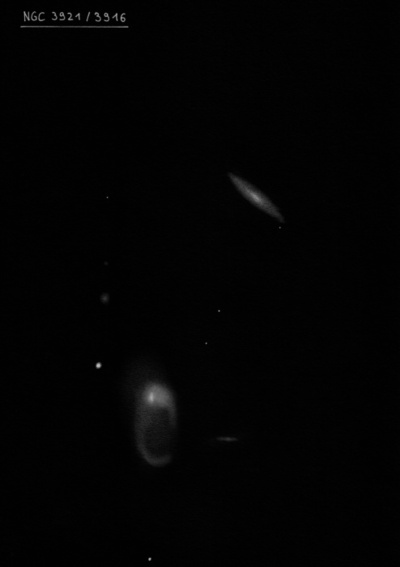
William Herschel discovered NGC 3921 = H II-788 = h997 on 14 Apr 1789 (sweep 920) and recorded "Two, the south-following [NGC 3921], which is that of which the place is taken, is pB, S [with another [NGC 3916] north-preceding about 5', it precedes the other about 5 sec in time.)" JH logged "pB; R; psbM" and measured an accurate position. The RA in the RNGC is 0.5 min too large.
400/500mm - 17.5" (3/19/88): fairly faint, small, round, small very bright core. Brightest of three with NGC 3916 4.5' NNW and MCG +09-19-213 5' W.
900/1200mm - 48" (5/12/12): at 488x; the "core" of this disrupted galaxy is very bright, oval 4:3 N-3, ~25"x20", fairly sharply concentrated with a small intense nucleus that brightens to a blazing stellar center. A large, faint tear-drop shaped plume extends from the core 1' due south. The plume forms an elongated loop or ring with a brighter rim. The offset, brilliant core sits at the north edge of the loop.
PGC 2489542 lies 1.2' SW and appeared faint, very small, elongated 2:1 E-W, ~12"x6". PGC 2491113 is 2.4' NNE and was fairly faint, very small, slightly elongated, 12"x9". These two fainter galaxies are captured in Arp's 200-inch photo. Also nearby are MCG +09-19-213 5' WSW and NGC 3916 5' NW. NGC 3921 is considered a proto-typical late stage merger-remnant with two long, crossed tidal tails indicating a merger of two former disk galaxies.
Notes by Steve Gottlieb